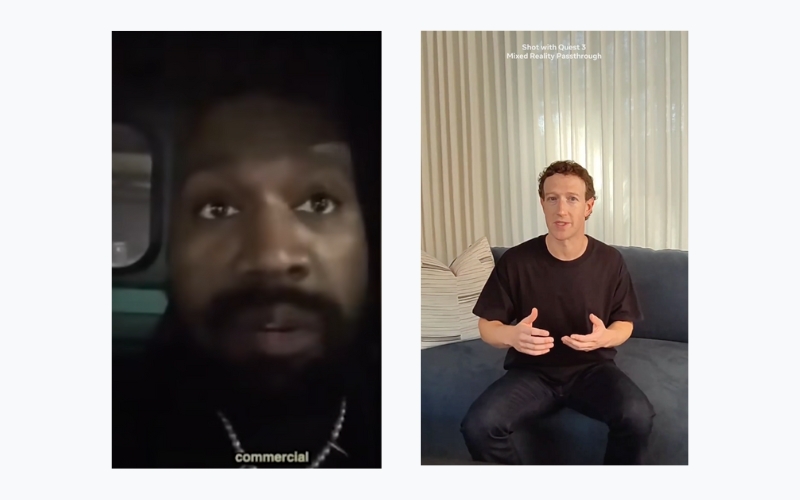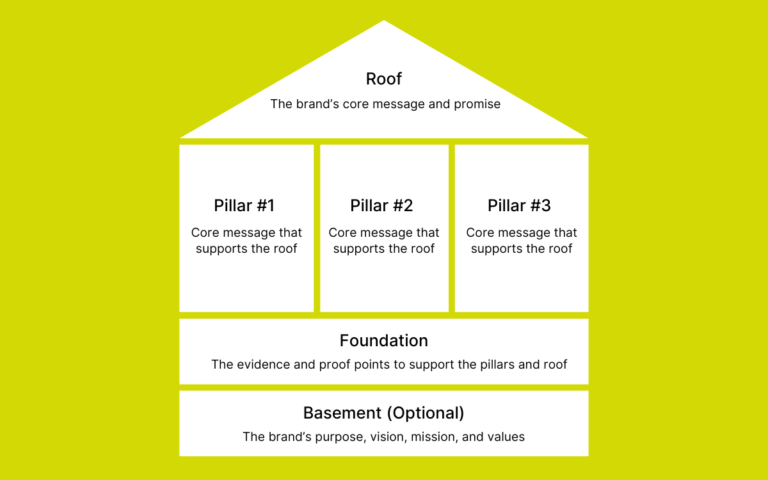The world of CEO branding seems to have swapped out its three-piece suit for its favorite pair of jeans and pulled up a chair to chat with friends. It’s a shift I’ve been watching closely, and frankly, it’s both refreshing and overdue. The old playbook, where CEOs hovered like distant figures behind the scenes, is being rewritten. Now, they’re front and center, sharing moments of authenticity that cut through the noise like never before.
I love witnessing authenticity seamlessly blended within branding. Watching celebrities like Kanye West and Mark Zuckerberg embrace such conviction reinforces my perspective. Take Kanye’s latest $7 million Super Bowl feat – he didn’t frivolously burn cash. Instead, he opened a door into his universe with just an iPhone, which felt more like a livestream than a traditional commercial. Equally, Zuckerberg’s relaxed at-home product teardown wasn’t like a traditional corporate demo reel. Instead, it felt like getting a personal recommendation from a friend.
This turn towards genuine authenticity is a breath of fresh air. It’s not about being perfect anymore; it’s about being real. When brands stay honest, customers connect more. This approach doesn’t just drive sales; it builds trust and connection in a way that glossy ads can’t match.
I’ve always pushed for brands to be more transparent and relatable. Seeing these CEOs use their platforms to showcase their brand’s values in a direct, unfiltered way is a powerful validation. It’s not just about selling a product anymore; it’s about sharing a piece of who you are with your audience.
We’re stepping into a new chapter of brand communication, where the lines between personal and corporate branding blur into something genuinely impactful. I’m eager to see how this evolution unfolds. It promises to make our interactions with brands more personal, meaningful, and human.
Proven Systems for Business Owners, Marketers, and Agencies
→ Our mini-course helps you audit and refine an existing brand in 15 days, just 15 minutes a day.
→ The Ultimate Brand Building System is your step-by-step blueprint to building and scaling powerful brands from scratch.
Table of Contents
Kanye West’s Raw Super Bowl Ad
As I sat down to watch Kanye West’s Super Bowl ad (a venture that cost him $7 million), I laughed at the sheer audacity and brilliance of it. Here he was in the backseat of his car, using nothing but his phone to capture a moment that felt as genuine as a chat with an old friend. No flashy production, no dramatic music, just Kanye and his pitch, raw and unfiltered. It was completely different from what we expected from Super Bowl commercials, yet it was very effective.
Adopting this strategy broke through the noise, not with flashy visuals or catchy jingles, but with its raw simplicity and authenticity. While I don’t necessarily endorse every marketing stunt or action Kanye has undertaken in the past, it’s undeniable that he frequently ignites significant reactions, weaves compelling narratives, and achieves viral marketing success. The Super Bowl ad felt less like a classic commercial and more like a raw signal cutting through the clutter – radical candor highlighting that real recognizes real.
And of course, the results spoke volumes. Kanye’s brand saw explosive sales, leading to an astonishing $19 million in sales on Yeezy.com by sparking conversations and drawing attention in ways that a conventional ad would not. It was a reminder that usually, less is more. Kanye’s choice to be so unapologetically himself, to share a piece of his world without the usual polish, resonated deeply with audiences.
Many in the field of brand strategy can become preoccupied with adhering to established guidelines, turning every campaign into a meticulous box-ticking exercise. Yet, Kanye’s recent marketing stunt serves as a vivid reminder that sometimes, the most effective strategy is to toss the rule book out the window and follow your gut instinct.
Zuckerberg’s Informal and Transparent Brand Messaging
In highly controlled environments of large corporations, where every piece of content undergoes layers of scrutiny and approval, Mark Zuckerberg’s approach to promoting Meta’s Quest 3 was a refreshing change from the norm. Usually, brand campaigns resemble well-oiled machines, with every nut, bolt, and pixel obsessively tightening to grab as many eyeballs as possible. Amid a sea of polished advertisements for Apple’s Vision Pro, which had me almost convinced to jump ship to Apple, Zuckerberg’s candid product breakdown was a game-changer.
Turns out a multi-billionaire casually chilling in his living room can drive an effortlessly brilliant branding play. His video, spanning just over three and a half minutes, was a simple yet effective demonstration of the Quest 3, directly comparing it with the much-hyped Apple Vision Pro. While Apple drowned the internet in cinematic Vision Pro content, Mark Zuckerberg simply put on a Quest 3 headset, fired up Instagram, and started talking tech — raw, unscripted, and straight from the tap. This approach showcased the device’s capabilities and created a layer of genuine credibility.
The lesson is clear: Overthinking and overengineering brand strategies can sometimes distance us from the people we aim to connect with. In one fell swoop, Zuckerberg humanized his brand, which was a deliberate stride toward authenticity. By tossing aside the corporate veneer and engaging with his audience directly, he not only highlighted the Quest 3’s features in a relatable manner but also cemented Meta’s image as a brand that values transparency and user-centricity.
This wasn’t a hard sell — it was an eye-level exchange elevating honesty over hype, offering a clear comparison that made me reconsider my leaning toward Apple. The video struck a chord because it felt like a genuine attempt to inform rather than sell, a rare quality in today’s saturated ad landscape. Zuckerberg’s presentation was rooted in authenticity, focusing on raw facts and direct comparisons without the fluff.
Zuckerberg’s stripped-down, fact-based approach cut through the noise of the Vision Pro’s glossy campaigns, which made me reevaluate what I valued in tech products. The simple clip distilled the magic of no-frills marketing, demonstrating that sometimes, the most compelling sales pitch is just laying out the bare facts and letting them speak for themselves. In a world where hype often overshadows substance, Zuckerberg’s review was a refreshing reminder of the impact genuine authenticity can have on consumer decision-making.
The Importance of Authenticity in Branding
Over the past year, I’ve noticed a huge shift in consumer preferences, particularly among younger generations like Gen-Z. They are simply tired of all the shiny, perfect stuff big companies keep showing them. This trend is evident with the vast surge of user-generated content (UGC) on platforms like TikTok, where authenticity reigns supreme. Similarly, on YouTube, there’s a move towards content that feels more in the moment and less choreographed. It is clear that audiences seek authenticity and realness over polished perfection.
Brands need to pay attention to this big move towards realness. The old marketing playbook of flawless filters, over-choreographed everything, and breathless hype now gathers dust as consumers basically roll their eyes. Instead, what resonates with consumers today is a sense of genuine connection, where brands showcase their true selves, imperfections included. This doesn’t mean abandoning professionalism but embracing a more relatable, transparent way of communicating.
Brands willing to adapt to this change by adopting a more authentic approach to their marketing strategy will reap rewards. Creating a more honest and down-to-earth brand image will allow them to connect with their audience by building trust and loyalty. This transition isn’t just a fleeting trend but a fundamental shift in what consumers expect from the brands they know and love.
Navigating the Shift From Corporate to Conversational
Observing today’s branding landscape reveals a tectonic shift underway in how companies communicate with the connected masses. The era of top-down, corporate-driven communication is giving way to a more conversational, peer-to-peer style of engagement. This change is primarily driven by the demand for a more personal touch in brand interactions, especially from younger audiences who crave meaningful connections rather than one-way sales pitches.
The rise of social media, specifically short-form reels, has facilitated this shift. Platforms that encourage dialogue and community-building have become invaluable tools for brands looking to foster a sense of belonging and loyalty with their customers.
This new approach doesn’t just apply to social media, however, it’s reshaping email marketing, customer service, and even the way companies present themselves on their websites. The emphasis is on creating a friendly, accessible voice that invites customers into a dialogue, treating them as equals rather than passive consumers. This can mean sharing stories about the challenges and successes behind the scenes, asking for feedback, or simply having a bit of fun and showing the brand’s human side.
Yet, embracing this conversational approach demands more than just tweaking the tone of communication. It requires a cultural shift within the organization, one that values transparency, responsiveness, and a genuine desire to listen and adapt based on customer feedback. It’s about moving from a monologue to a dialogue, where both sides have a voice and a stake in the relationship.
For brands ready to make this leap, the rewards can be substantial. Engaging customers in a more relaxed, personal manner can deepen their emotional connection to the brand, leading to higher levels of engagement, loyalty, and advocacy. However, it also poses challenges, requiring brands to be more agile, authentic, and attuned to the nuances of human conversation.
In sum, the transition from corporate to conversational is not just a trend but a significant shift in brand-customer relationships. For companies willing to embrace this change, it offers a path to building stronger, more meaningful connections with their audience, ensuring their relevance in a rapidly evolving market.
Embracing the New, Raw & Authentic Era of Brand Communication
The way brands communicate with their audience is evolving significantly. People, especially the younger crowd, are moving away from polished, perfect ads.
Consumers are no longer just passive observers. They want to engage, to have a say, and to feel a part of the brand’s journey. They’re looking for transparency, authenticity, and a sense of shared values. This craving for genuine interaction is reshaping the brand-consumer relationship into something more dynamic and personal.
Kanye West and Mark Zuckerberg have shown us that authenticity can cut through the noise of traditional marketing. By simply being themselves and sharing their brand’s story in an unfiltered way, they’ve managed to create a more personal connection with their audience. It’s a reminder that the essence of effective communication isn’t in the gloss but in the genuineness of the message.
As we look to the future, it’s clear that brands willing to embrace this new era of communication will be the ones that thrive. Moving away from scripted messages to a more open, conversational style can make a world of difference. This approach isn’t about abandoning professionalism but finding a balance that allows a brand’s true personality to shine through.
When it comes to branding, creativity, and authenticity should steer the ship – not rigid playbooks. The rewards for making this leap are profound: deeper loyalty, enhanced trust, and a stronger, more vibrant community of supporters. As we move forward, let’s remember that at the heart of every brand is usually a founder with an interesting story to tell, and sharing that story in a genuine, relatable way is the key to forging lasting connections in this new era of brand communication.









